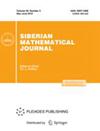论丹乔伊-欣钦因与 $ \operatorname{HK}_{r} $ - 积分的关系
IF 0.7
4区 数学
Q2 MATHEMATICS
引用次数: 0
摘要
Abstract 我们将 Musial 和 Sagher 的 \( \operatorname{HK}_{r} \) -integration 概念置于近似 Henstock-Kurzweil 积分理论中。如果我们限制 \( \operatorname{HK}_{r} \) -积分,要求不确定的 \( \operatorname{HK}_{r} \) -积分是连续的,那么它就会包含在经典的登乔伊-金廷积分中。我们提供了一个直接论证,证明这种包含是适当的。本文章由计算机程序翻译,如有差异,请以英文原文为准。
On the Relation between Denjoy–Khintchine and $ \operatorname{HK}_{r} $ -Integrals
Abstract
We locate Musial and Sagher’s concept of \( \operatorname{HK}_{r} \) -integration within the approximate Henstock–Kurzweil integral theory. If we restrict the \( \operatorname{HK}_{r} \) -integral by the requirement that the indefinite \( \operatorname{HK}_{r} \) -integral is continuous, then it becomes included in the classical Denjoy–Khintchine integral. We provide a direct argument demonstrating that this inclusion is proper.
求助全文
通过发布文献求助,成功后即可免费获取论文全文。
去求助
来源期刊
CiteScore
1.00
自引率
20.00%
发文量
88
审稿时长
4-8 weeks
期刊介绍:
Siberian Mathematical Journal is journal published in collaboration with the Sobolev Institute of Mathematics in Novosibirsk. The journal publishes the results of studies in various branches of mathematics.

 求助内容:
求助内容: 应助结果提醒方式:
应助结果提醒方式:


